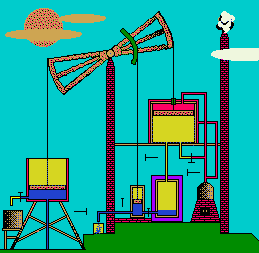The first watt engine

This engine worked a crossbeam for pumping. The cylinder was closed (by a cap) and heated by a warm steam jacket. The condenser, positioned underground, was cooled and vacuum operated (by a pump).
When the piston reached the top of its stroke the exhaust-valve opened and a partial vacuum was produced below the piston (inside the cylinder communicating to the condenser).
Above the piston, at the same time, the entrance of steam helped the atmospheric pressure to drive the piston down. On this stroke the crossbeam raised water in the pump. When the piston reached the bottom of the stroke the inlet valve closed and an equilibrium valve opened to allow steam to pass from above to below the piston. The engine piston (now with the same pressure above and below) was driven up by the crossbeam and the descent of the very, very heavy pump piston and rod. Note the presence of the condenser and the warm steam jacket that surrounds the cylinder.